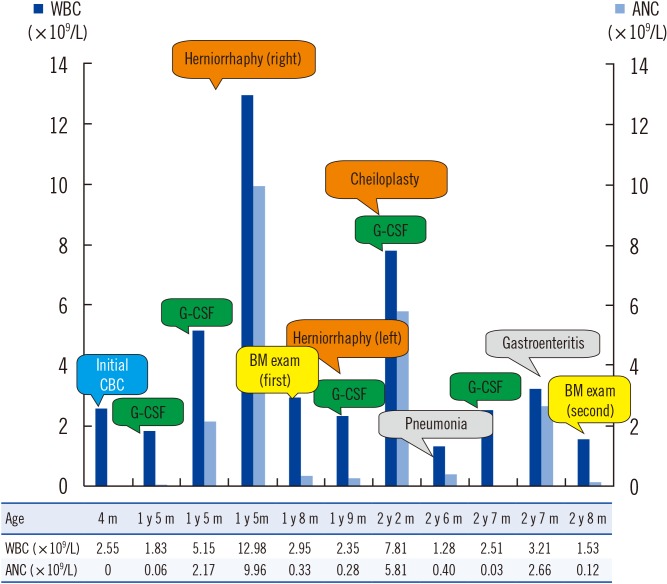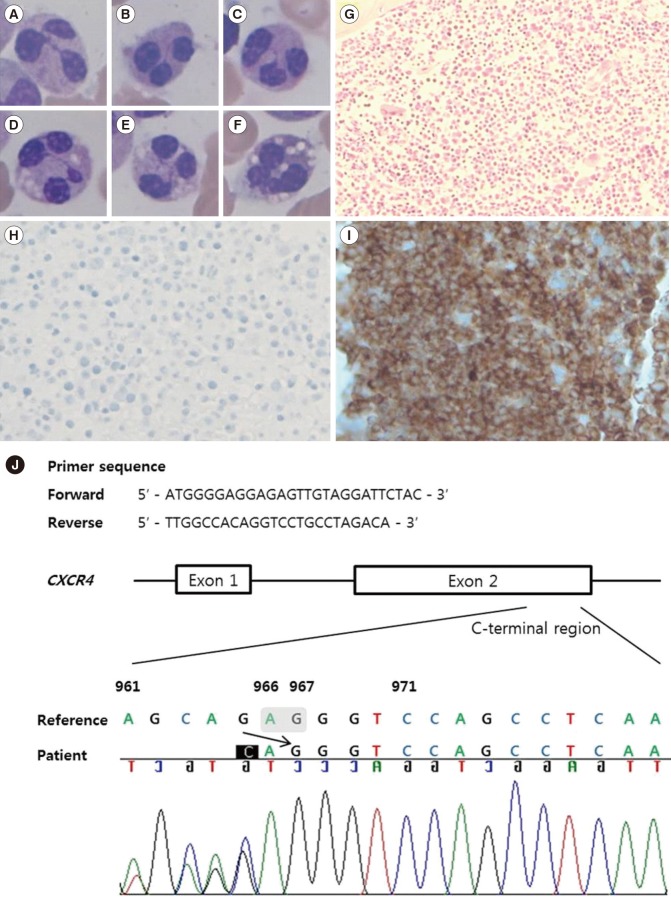Ann Lab Med.
2017 Sep;37(5):446-449. 10.3343/alm.2017.37.5.446.
WHIM Syndrome With a Novel CXCR4 Variant in a Korean Child
- Affiliations
-
- 1Department of Laboratory Medicine, Seoul National University College of Medicine, Seoul, Korea. soonlee@snu.ac.kr
- 2Cancer Research Institute, Seoul National University College of Medicine, Seoul, Korea.
- 3Department of Pediatrics, Seoul National University College of Medicine, Seoul, Korea.
- KMID: 2383923
- DOI: http://doi.org/10.3343/alm.2017.37.5.446
Abstract
- No abstract available.
Figure
Reference
-
1. Pozzobon T, Goldoni G, Viola A, Molon B. CXCR4 signaling in health and disease. Immunol Lett. 2016; 177:6–15. PMID: 27363619.2. Ana Rath, Stéphanie Nguengang Wakap, Samuel Demarest, Valérie Lanneau (Eds), Prevalence of rare diseases: Bibliographic data, Orphanet Report Series, Rare Diseases collection, November 2016, Number 1 : Diseases listed in alphabetical order. Updated on Nov 2016. http://www.orpha.net/orphacom/cahiers/docs/GB/Prevalence_of_rare_diseases_by_diseases.pdf.3. Kawai T, Malech HL. WHIM Syndrome: congenital immune deficiency disease. Curr Opin Hematol. 2009; 16:20–26. PMID: 19057201.4. Donadieu J, Fenneteau O, Beaupain B, Mahlaoui N, Chantelot CB. Congenital neutropenia: diagnosis, molecular bases and patient management. Orphanet J Rare Dis. 2011; 6:26. PMID: 21595885.5. Bernhagen J, Krohn R, Lue H, Gregory JL, Zernecke A, Koenen RR, et al. MIF is a noncognate ligand of CXC chemokine receptors in inflammatory and atherogenic cell recruitment. Nat Med. 2007; 13:587–596. PMID: 17435771.6. Pavlasova G, Borsky M, Seda V, Cerna K, Osickova J, Doubek M, et al. Ibrutinib inhibits CD20 upregulation on CLL B cells mediated by the CXCR4/SDF-1 axis. Blood. 2016; 128:1609–1613. PMID: 27480113.7. Beaussant Cohen S, Fenneteau O, Plouvier E, Rohrlich PS, Daltroff G, Plantier I, et al. Description and outcome of a cohort of 8 patients with WHIM syndrome from the French Severe Chronic Neutropenia Registry. Orphanet J Rare Dis. 2012; 7:71. PMID: 23009155.8. Pawig L, Klasen C, Weber C, Bernhagen J, Noels H. Diversity and inter-connections in the CXCR4 chemokine receptor/ligand family: molecular perspectives. Front Immunol. 2015; 6:429. PMID: 26347749.9. Hunter ZR, Xu L, Yang G, Zhou Y, Liu X, Cao Y, et al. The genomic landscape of Waldenström macroglobulinemia is characterized by highly recurring MYD88 and WHIM-like CXCR4 mutations, and small somatic deletions associated with B-cell lymphomagenesis. Blood. 2014; 123:1637–1646. PMID: 24366360.10. Balabanian K, Lagane B, Pablos JL, Laurent L, Planchenault T, Verola O, et al. WHIM syndromes with different genetic anomalies are accounted for by impaired CXCR4 desensitization to CXCL12. Blood. 2005; 105:2449–2457. PMID: 15536153.
- Full Text Links
- Actions
-
Cited
- CITED
-
- Close
- Share
- Similar articles
-
- Research Progress of CXCR4-Targeting Radioligands for Oncologic Imaging
- Extracellular Hsp70 Is Involved in the CXCL12/CXCR4 Pathway in Primary Human Nasal Epithelial Cells: A Preliminary Study
- Association of CXCR4 Expression with Metastasis and Survival among Patients with Non-small Cell Lung Cancer
- Isoorientin Suppresses Invasion of Breast and Colon Cancer Cells by Inhibition of CXC Chemokine Receptor 4 Expression
- Differential Expression of CXCR4 in Conventional High-grade and Low-grade Central Osteosarcoma and Its Prognostic Implications



